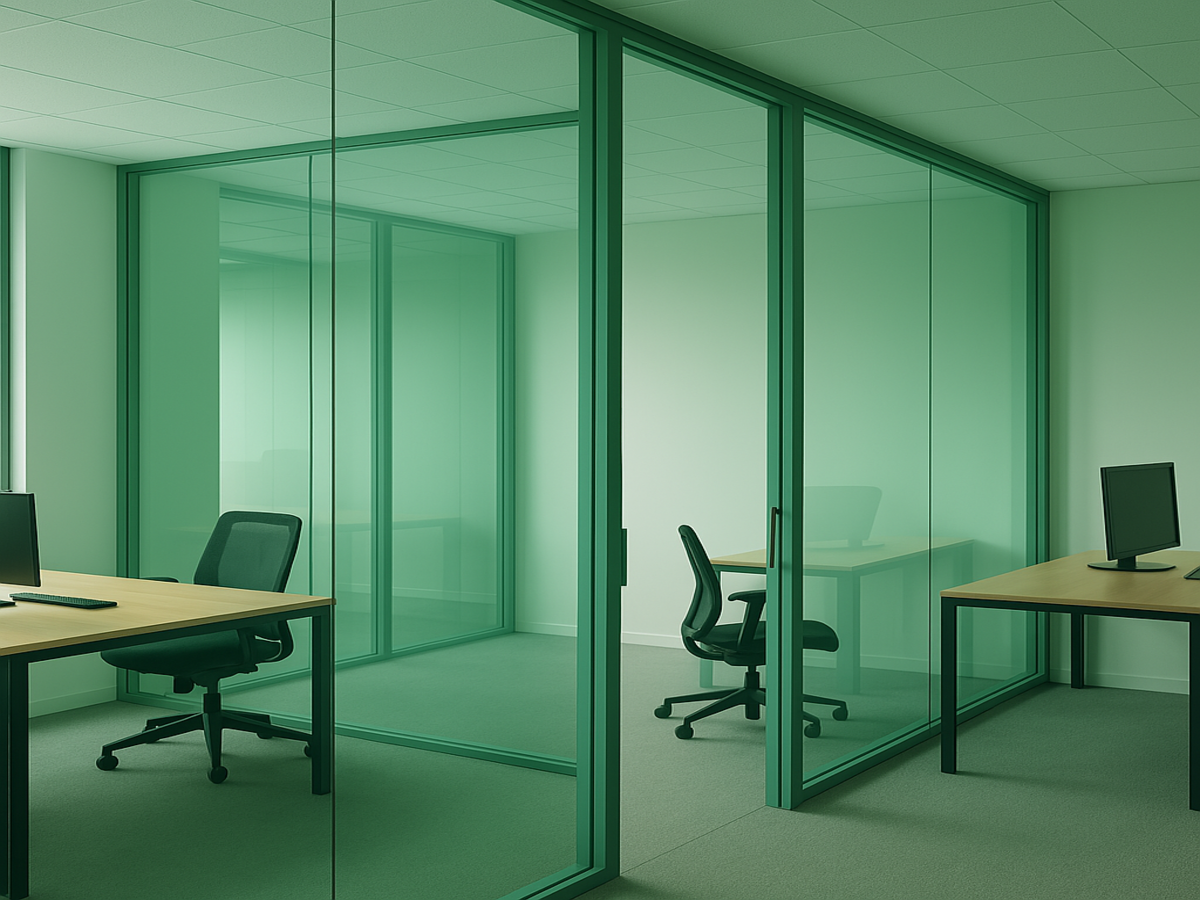
Green tinted glass is a refined choice that elevates spaces with calm tones and visual depth. It brings a sense of quiet sophistication while offering practical benefits like reduced glare, energy savings, and added privacy. As designers look for smart ways to blend beauty with performance, this glass type continues to rise in popularity across interiors. From homes to offices to storefronts, its subtle colour and clean finish make a lasting impression. By the end of this blog, you’ll understand exactly how green tinted glass works, where it fits best, and why it could be the perfect upgrade for your space.
What Exactly Is Green Tinted Glass?
Green tinted glass is a type of coloured glass that gets its distinctive hue from a small amount of iron oxide added during the manufacturing process. This iron content subtly shifts the tone of the glass, giving it a cool green tint that feels both modern and timeless. The colour is not painted or layered on, it’s embedded within the glass itself, which means it won’t fade, peel, or lose its clarity over time.
The green tint isn’t just about aesthetics. It serves a powerful visual purpose by filtering light in a way that reduces harsh brightness. In daylight, it reflects a subtle colour shift that adds dimension to walls and surfaces. In the evening, it softens artificial lighting, creating an inviting glow that makes any space feel more composed and curated.
Compared to other types of tinted glass, such as bronze or grey, green tinted glass offers a more natural and soothing tone. It creates a sense of calm while still making a bold visual impact. The shade can range from barely-there misty green to deeper, more expressive tones depending on thickness and lighting conditions.
Where Does Green Tinted Glass Work Best?
1. Office partitions
Green tinted glass brings a sense of calm and separation to busy workspaces. It helps define areas for focused work or collaboration without feeling closed off. The soft green tone adds character and a polished feel to modern office layouts.
2. Meeting rooms
It offers the perfect blend of transparency and privacy, allowing light to flow through while subtly obscuring sensitive conversations. The cool green hue sets a relaxed tone for discussions and brainstorming sessions. It also helps reduce glare from screens and devices during meetings.
3. Residential interiors
Used in staircases, balustrades, or bathroom enclosures, green tinted glass introduces a sense of luxury and tranquility. It blends seamlessly with natural materials like stone and wood, enhancing the overall mood of the space. Its muted tone creates an elegant contrast without overpowering the design.
4. Storefronts
In retail environments, green tinted glass catches the eye with its modern finish while protecting displays from excessive brightness. It reduces exposure to UV rays, helping preserve fabrics, merchandise, and signage. The subtle colour adds sophistication to the brand’s visual identity.
5. Sunlit spaces
In sun-soaked environments, this glass significantly cuts down on glare and heat penetration. Over time, it helps reduce wear on furniture, flooring, and fabrics exposed to daily sunlight. This makes it ideal for glass-heavy spaces like atriums, lobbies, and sunrooms that need better light control.
Why Are Designers Choosing Green Tinted Glass More Often?
1. Style with subtle coverage
Designers appreciate how green tinted glass creates defined zones without the need for heavy walls or solid barriers. It offers just enough coverage to separate spaces while still feeling airy and refined. The gentle green tone adds depth and elegance to any layout.
2. Seamless fit for modern and industrial designs
Its cool, muted colour works beautifully with raw materials like concrete, steel, and timber. It complements minimalist interiors just as well as bold, statement-driven ones. The result is a cohesive design that feels intentional and balanced.
3. Energy-conscious choice
Green tinted glass helps manage indoor temperatures by softening the intensity of sunlight. This can reduce the strain on cooling systems and support more efficient energy use. Designers see it as a stylish way to contribute to long-term sustainability.
4. Helps control heat
By filtering the sun’s rays, green tinted glass limits heat build-up in interior spaces. This keeps rooms feeling cooler, especially in locations with strong sun exposure. It adds both comfort and performance to the overall design approach.
How Does It Compare to Other Tinted Glass Options?
Here’s how green tinted glass measures up against other popular tinted glass types. Each option brings its character and strength.
| Feature | Green tinted glass | Grey tinted glass | Bronze tinted glass |
|---|---|---|---|
| Tone and feel | Offers a cool, calm presence that adds a fresh layer of sophistication to interiors. | Has a neutral, almost monochrome tone that works well in sleek, high-contrast designs. | Brings a rich, warm finish that leans traditional and feels grounded in earthy tones. |
| Light control | Softens incoming rays without making a room feel dull or closed in. | Dims sunlight more noticeably, creating a slightly shadowed effect throughout the space. | Filters light gently, adding a golden touch to rooms with lots of sun. |
| Design compatibility | Blends well with natural materials, bold accents, or minimalist palettes. | Matches clean, modern environments and urban-inspired interiors. | Pairs beautifully with rustic textures, dark woods, or vintage décor elements. |
| Heat filtering | Helps reduce indoor warmth by lowering sun exposure and creating a cooler atmosphere. | Offers solid protection against heat but may slightly darken the overall look of the space. | Provides moderate relief from heat while adding an inviting, sun-kissed glow. |
| Best used in | Homes, office partitions, meeting rooms, and shopfronts that need style and comfort. | Corporate buildings, tech spaces, or interiors that favour sharp lines and minimal colour. | Hospitality, residential spaces, or showrooms with warm-toned styling and softer lighting. |
Pros and Cons of Green Tinted Glass
Green-tinted glass has been a popular choice in both residential and commercial buildings, often used in windows, facades, and skylights. However, like any material, it comes with both advantages and disadvantages. Let’s break it down in detail.
Pros
1. Aesthetic appeal: Green-tinted glass gives buildings a clean, modern, and subtle elegance. Its soft hue blends well with natural surroundings and adds a refined tone to urban structures. Whether used in residential or commercial projects, it enhances the visual experience without being overpowering.
2. Solar heat control: This glass helps reduce heat gain by absorbing and reflecting part of the sun’s rays. In warm climates, this can lessen the reliance on air conditioning and contribute to better energy efficiency. It’s a passive way to create a cooler, more comfortable interior.
3. UV and glare reduction: Green-tinted glass cuts down on glare and harmful ultraviolet rays, protecting furniture, fabrics, and artwork from fading. It also helps create more comfortable indoor lighting, especially in spaces exposed to intense sunlight.
4. Improved privacy: While not opaque, the green tint makes it harder to see through the glass from the outside during the day, offering a level of visual privacy, ideal for both homes and office spaces.
Cons
1. Reduced natural light: The same tint that blocks heat and UV rays can slightly dim interior spaces. In rooms that rely heavily on daylight, this can make spaces feel less bright and may increase the need for artificial lighting.
2. Limited thermal performance in harsh climates: Though it reduces solar heat, green-tinted glass isn’t as effective as darker tints or specialized coatings (like Low-E glass) in very hot regions. It may need to be combined with other energy-efficient glazing solutions.
3. Subtle color distortion: The green hue can slightly alter how colors appear when viewed through the glass. While usually minor, this shift may be a concern in spaces where color accuracy matters, like studios or showrooms.
4. Higher cost: Green-tinted glass is typically more expensive than clear glass. While the energy savings can offset this over time, the upfront cost may be a consideration for budget-conscious projects.
Can You Use Green Tinted Glass in Office Partitions?
Yes, green-tinted glass is a smart and stylish choice for office partitions. Let’s explore its advantages in more detail, especially when paired with common partition systems and configurations.
Advantages of green-tinted glass in workspace design
1. Soothing colour palette
The subtle green hue of this glass introduces a sense of calm into the office environment. Unlike stark clear or frosted glass, the tint softens visual distractions and reduces the clinical feel that often comes with traditional office designs. Psychologically, green is associated with tranquility, balance, and nature; qualities that contribute to a more relaxed and focused work atmosphere.
In fast-paced work settings, especially those that demand creativity or concentration, the muted tone of green-tinted glass can help reduce visual fatigue. It brings a touch of serenity without being bold or intrusive, making it a great fit for workspaces that aim to feel both contemporary and inviting.
2. Focus-enhancing light control
Natural light is essential in modern office design, but excessive glare and direct sunlight can create discomfort. Green-tinted glass strikes a balance, it allows daylight to pass through while filtering out the harshness that can cause eye strain and distraction. By diffusing light gently, it creates an environment where employees can work comfortably for longer periods, especially near windows or open-plan zones.
This kind of light control is especially useful in shared workspaces, conference rooms, or hot-desking areas where computer screens are in constant use. The green tint cuts glare without needing heavy blinds or shades, maintaining openness while still enhancing functionality.
3. Compatibility with sliding doors, aluminium frames, and frameless systems
Green-tinted glass is highly adaptable in terms of design systems. It pairs beautifully with various modern partition solutions:
a. Sliding glass doors: These work well in collaborative spaces or executive offices, and the green tint adds a polished, high-end feel. The sliding mechanism keeps floor space open while the glass keeps visual continuity throughout the workspace.
Related Read: Sliding Glass Doors
b. Aluminium frames: Combining green-tinted glass with sleek aluminium framing adds a strong, structured look. The metallic tones of aluminium contrast elegantly with the soft green hue, creating a modern industrial aesthetic. It’s great for tech offices, studios, or startups aiming for a minimalist yet functional vibe.
c. Frameless systems: For a truly seamless and modern appearance, frameless systems allow the green glass to shine as the focal point. They work beautifully in minimalist offices or where design simplicity is a priority. The frameless look enhances openness while still offering division and sound dampening.
4. Ideal configurations
The versatility of green-tinted glass allows it to be used in several practical layouts:
Full-height walls: These are perfect for creating enclosed offices, meeting rooms, or quiet zones. The green tint provides a level of privacy while still allowing a connection to the larger space. Full-height installations also help with sound insulation, especially when paired with the right framing and seals.
Partial panels: If you’re designing workstations or semi-private booths, partial panels of green-tinted glass can define areas without closing them off entirely. They maintain openness while guiding movement and creating subtle boundaries. Partial panels work particularly well in agile office designs.
What Should You Know Before Installing It?
1. Maintenance and cleaning tips
Green-tinted glass is relatively low-maintenance but requires regular cleaning to preserve its clarity and color depth. Use a mild glass cleaner and a soft, lint-free cloth to avoid streaks or surface damage. Avoid abrasive pads or harsh chemicals, especially near the edges where coatings or seals may be present.
2. Light transmission factors
While green-tinted glass reduces glare and filters sunlight, it also slightly dims natural light; something to consider in dimly lit spaces. Its light transmission rate typically ranges between 50%–70%, depending on thickness and tint level. Ensure the space receives adequate lighting, especially for work-heavy zones.
3. Considerations for thickness, edge treatment, and safety
Choose the right thickness based on the structure and safety needs of the partition. Polished or beveled edges enhance aesthetics and reduce risk of injury, especially in frameless systems. Tempered or laminated versions are essential for safety compliance, as they minimize injury in case of breakage.
Want to Mix It with Other Glass Features?
1. Glass doors and cladding
Green-tinted partitions can be beautifully extended with matching or clear glass doors, creating visual continuity throughout the space. When paired with glass cladding on walls or columns, it adds depth, texture, and a cohesive design language.
2. Double-glazed systems
Green-tinted glass works well as part of double-glazed units, especially in climate-controlled or sound-sensitive office environments. The inner air or gas layer enhances insulation, while the tinted pane adds glare control and UV protection. It’s an energy-efficient way to balance comfort with design impact.
3. Textured or fluted pairing
Mixing green-tinted glass with textured or fluted glass introduces visual interest and tactile contrast. Fluted panels diffuse light in stylish waves, adding a layered sophistication to otherwise sleek surfaces. This pairing works beautifully in partitions, feature walls, or breakout areas needing both form and function.
FAQs
Green tinted glass helps reduce heat and glare while providing a subtle, stylish look for modern interiors.
Yes, it offers moderate privacy without completely blocking light—making it ideal for partitions and meeting rooms.
It’s suitable for exterior use like facades or shopfronts, especially in sunny climates, due to its UV-reducing properties.
It reduces solar heat gain, helping to keep interiors cooler and potentially reducing cooling costs.
Yes, it can be polished, tempered, laminated, or even combined with frosted or textured finishes.














